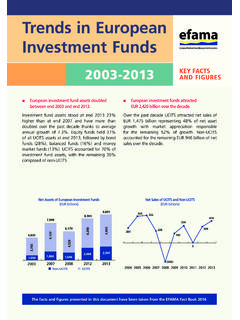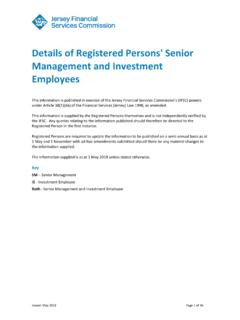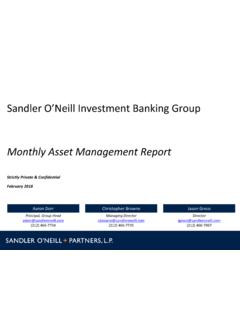Transcription of Skill through scale? The role of M&A in a …
1 Casey Quirk by Skill through scale ? the role of M&A in a consolidating industry Investment management 2017 M&A Outlook Deteriorating economics, distributor consolidation, the need for new capabilities, and a shifting value chain are combining to set off an accelerated and different round of merger & acquisition (M&A) activity in the investment management industry . We expect to see brisk M&A activity continuing in 2017 (and beyond) driven more than ever before by consolidation pressures, and centered on four primary deal types: Transformative scale acquisitions Pure consolidating deals Capability-based transactions Value chain-extending transactions Four strategic catalysts will drive M&A activity in the sector: Deteriorating industry economics Distributor consolidation A need for new capabilities A shifting value chain Successful transactions will be characterized by: Clear cost and revenue synergies to unlock investment capital Leveraging data and technology to drive competitive advantage Better positioning to respond to fiduciary-oriented change Most deals will require substantially greater integration than the industry has tackled historically and make pre- and post-deal integration planning essential.
2 In many cases, integration will require substantial restructuring of investments, distribution, and operations. Successful transactions will be characterized by: Integrated leadership team and governance structures Competitive investments and distribution organizations Effective incentive alignment programs Brand and firm positioning Streamlined operating models Table of Contents Authorship Primary co-authors: Jeffrey A. Levi, Casey Quirk 2016 in John Marshall, Deloitte Expectations for Masaki Noda, Deloitte Benjamin F. Phillips, Casey Quirk Smart Next Contributors: Jason Langan, Deloitte Casey Quirk Thought Leadership Committee: Daniel Celeghin Yariv Itah Jeffrey A. Levi Benjamin F. Phillips Kevin P. Quirk J. Tyler Cloherty Casey Quirk by Casey Quirk helps clients develop broad business growth strategies, improve investment/product appeal and growth prospects, evaluate new market and product opportunities, and enhance incentive alignment structures.
3 Our unparalleled industry knowledge and experience, detailed proprietary data, and global network of relationships make Casey Quirk a leading advisor to the owners and senior executives of investment management firms in the world. Skill through scale ? the role of M&A in a consolidating industry 2. Introduction Investment management has become a fiercely competitive industry , increasingly shaped by the same winner-take-all and consolidation dynamics influencing other maturing financial services sectors. The gap is widening between leading and lagging asset/ wealth management firms, as they deal with to varying degrees of success a cost and customer conundrum that is challenging revenue growth and profitability in a maturing, oversupplied market (Figure 1). Figure 1: Global Asset management industry : Key Metrics Net New Flows and Fees Revenues and Margins Global ex-China, Net Flows as % of BoP AUM Global ex-China, Operating Margins by Cost Growth 4% NNF Rate 100 $350 60%.
4 + Fees $300 $324. + 3% 75. $250 $273. Operating Margin 40%. Organic Growth Revenue ($B). Basis Points $200 $216. 2% 50. $150. 20%. 1% 25 $100. $50 2. 0% 0% 0%. $0. Pre-crisis Recovery Stagnation 2011 2015 2021E. ('05 - '08) ('09 - '14) ('15 - '21). Revenue Margin at rate of historical cost growth (5%). Source: Institue/Casey Quirk/McLagan Performance Intelligence Study and Casey Quirk Analysis Strategy consultants from Casey Quirk describe a shifting operating environment in their 2016 white paper, Survival of the Fittest: Defining Future Leaders in Asset management . Key drivers of the new competitive environment include: Costs: Dwindling market returns, slowing organic growth, and contracting margins reveal that the industry is not as scalable as previously believed, with expected fixed cost increases (including technology upgrades to meet new compliance standards and digitalization demands) outpacing likely future revenue growth.
5 Additionally, as long-term capital market returns decline, and passive asset management products become more popular, fee pressure will rise. Customers: As individual investors, rather than institutions, begin to power revenue growth, investment management is starting to resemble other consumer-focused industries facing dramatically changing buying patterns; requests for innovative products; expectations for a differentiated; personalized experience and customized outcomes; and fee sensitivity. Skill through scale ? the role of M&A in a consolidating industry 3. With the investment management industry 's traditional cost and operating models under pressure, forward-thinking asset and wealth managers are looking for new ways to differentiate, expand capabilities, and increase revenue. One way to do this is through cost-cutting, finding new sources of funds for transformation. Those investment management organizations that focus on amassing and using available capital to invest in mergers, acquisitions, and partnering arrangements rather than those that pay out free cash as compensation or dividends will likely be better positioned to manage marketplace challenges and opportunities, and build the capabilities and scale they need to power revenue growth.
6 Unlike previous transactions in the investment management industry , consolidation pressures a focus on scale to combat deteriorating economics as well as support necessary reinvestment in new skills will drive the next round of M&A. Figure 2: Phases of Investment management M&A. 1980s - 1990s Early 2000s - Present 2009 - Present 2015 - 2020+. Initial Founders' Capability-Driven Post-Crisis industry Exits Acquisitions Buyouts Consolidation Driver: asset Driver: asset Driver: sellers Driver: declining management managers seeking (often banks) need economics and viewed as highly capability to solidify balance need for scale attractive business diversi cation sheets Acquisition of Deals often resulted in Strategic and nancial Never-before-seen boutiques, often bigger rms/brands buyers very active; led broad driver of by large nancial and represent some of to some large deals M&A; will result in services companies today's leaders largest competitive re-alignment in industry 's history We expect that most investment management M&A deals in 2017 and the next few years will be strategic, driving valuations upward, with the following primary deal types: Transformative scale acquisitions, driven by the quest for revenue and cost synergies that will help fund the infrastructure and operational changes necessary to compete.
7 These deals will be larger, include more mergers of equals, and likely continue to be global. Capability-based transactions, mostly representing bolt-on additions of innovative investment products and technology solutions, either to meet investors' evolving service expectations or to tap new markets. Deals that reflect a shifting value chain, with many asset managers securing firms that extend their capabilities in direct distribution, wealth management , and other advice services to differentiate from competitors. Pure consolidating deals, structured to spread costs over a larger client asset base; several may take place in the US and European mutual fund marketplaces. In this report, we review 2016 investment management M&A activity; share our expectations for 2017; and review selective trends and issues that have the potential to influence sector M&A in the coming year. Skill through scale ? the role of M&A in a consolidating industry 4.
8 2016 in Review As of December 31, the 2016 investment management (asset management & wealth management ) M&A. volume of 133 announced transactions was slightly lower than 2015's total of 145 deals but it was still a good year, particularly as average deal value increased from $ million in 2015 to $ million (Figure 3). Figure 3: Asset & wealth management Transactions Worldwide 160 145 $600. $ 133. 140. 118 $500. 111. Number of Completed Deals 120 110. 107. 103. Average Deal Value ($USm). 98 $400. 94. 100. $ 86. $ 80 $300. $ $ 60 $ $200. $ 40. $ $ $ $100. 20. 0 $- 2007 2008 2009 2010 2011 2012 2013 2014 2015 2016. # of Asset management Deals Average Deal Value - Asset management Source: SNL Financial and Note: Average deal size is based on disclosed deal values for asset and wealth managment transactions where 57%, 61%, 66%, 63%, 68%, 70%, 71%, 73%, 79%, and 81% of reported deals did not disclose deal values for 2007, 2008, 2009, 2010, 2011, 2012, 2013, 2014, 2015 and 2016.
9 Respectively. Grouping 2016's more significant deals by transaction type reveals some interesting macro-level trends: Within asset management , transactions in 2016 tended to have at least one of five objectives (Figure 4): Securing access to new capabilities, be it additional, more innovative investment strategies, or access to new market segments Continued globalization, primarily by finding ways to unite existing distribution networks across the US, EMEA and Asia-Pacific Cost synergies, increasingly cited as a core deal motivator Financial sponsor exits, as private equity investors take advantage of rising multiples paid by a growing number of strategic buyers Multi-affiliate firms remained active buyers, albeit more discriminating and strategic, focusing on new investment capabilities that would modernize their product arrays. Increasingly, multi-affiliate firms may rely on strategy more than simple financial engineering to drive value.
10 They also may start to fund larger transactions by reorganizing their existing affiliate structures to find further efficiencies and build globally recognized brands. Skill through scale ? the role of M&A in a consolidating industry 5. Figure 4: 2016 Asset management M&A Transactions Worldwide by Category 30. 28. 25. 20. 15. 12. 10. 10. 5. 3. 2. 0. Transformative Capability Consolidation Shifting Value Chain Financial Source: SNL Financial, P&I Online, Casey Quirk Analysis and Deloitte Analysis During 2016, a need for succession planning and liquidity drove a number of transactions among US wealth managers, as many US financial advisors reached retirement age. But several secular, more strategic trends also spurred deals (Figure 5): Consolidation, as various smaller wealth managers sought to improve profitability through economies of scale Expected activation of the Department of Labor's (DOL) fiduciary rule, which is anticipated to raise compliance costs on smaller wealth managers Access to new technologies and processes, not only to secure efficiencies but also as a response to the improved customer experience promised by increasingly prevalent robo-advisors A drive to access a wider range of clients, as Registered Investment Advisors (RIAs) in different geographies merged their books of business Bank and insurer interest, as some financial services companies secured wealth management skills to offer existing clients A number of financial advisory networks, backed by private equity in many cases, continued to roll up smaller RIA networks, a trend that likely will continue in 2017.






